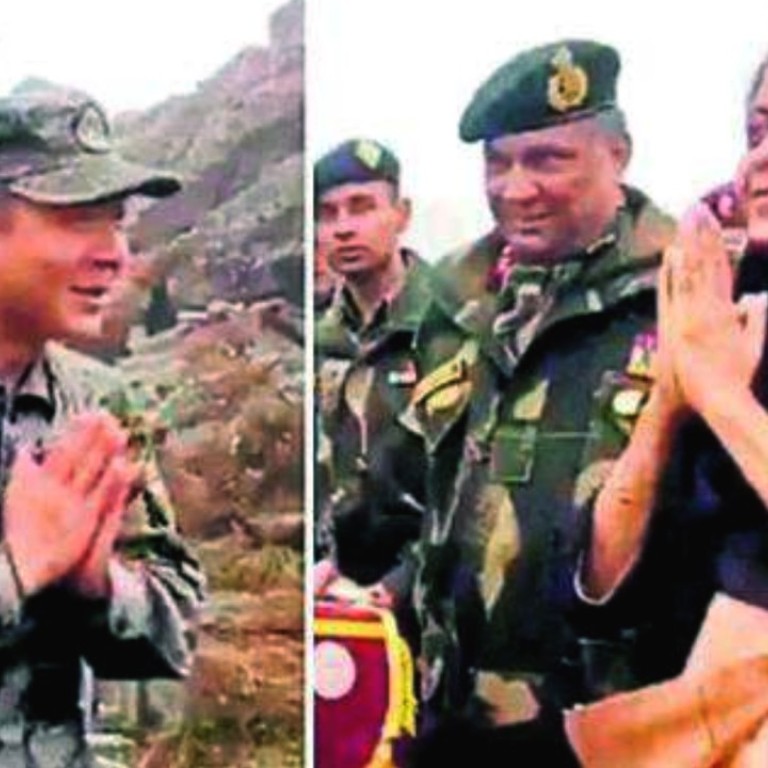
I say ‘namaste’, you say ‘nihao’ ... how India’s defence minister helped build bridges in frontline chat with Chinese soldiers
Visit to frontier was first by senior government figure since the two sides’ confrontation at Doklam plateau over the summer
India’s defence minister experienced an unexpected wave of goodwill from Chinese soldiers when she visited troops stationed on the frontier between the countries on Saturday.
Chinese observers described it as a goodwill gesture, while the foreign ministry on Monday said Beijing was willing to maintain peace along its border with India.
Two short videos of Nirmala Sitharaman’s interaction with Chinese troops at the border post in Nathu La were posted on the minister’s official Twitter account on Sunday.
“Do you know what namaste means?” she asks the Chinese soldiers.
“It means nice to meet you,” one of the Chinese troops replies.
Sitharaman then asks, “What would you say in Chinese?”
“We just say nihao,” the Chinese solider replies.
“So I say namaste,” the Indian defence minister says.
Sitharaman was meeting a People’s Liberation Army commander and captain and communicated with the help of an interpreter.
In another video posted on the minister’s Twitter account, she wishes good luck to the Chinese people.
“India and China are both great nations. Good luck to your country,” the Chinese commander replies.
The Chinese soldier doing the translating introduces himself to Sitharaman, saying his family name, Wang, means “king”.
“Very good,” the Indian defence minister replies. “And to have a king [doing] the translation.”
“My English is just so-so ... apologies,” Wang says.
The Nathu La post is the last one along the border between Sikkim on the Indian side and Tibet on the Chinese side.
India’s Economic Times newspaper reported that Sitharaman’s trip on Saturday was the first high-level visit to the area following a protracted stand-off between Indian and Chinese troops at the Doklam plateau that ended on August 28.
The dispute was about 30km away from where the minister was visiting, in an area claimed by both Beijing and Bhutan, an ally of India, and lasted for 73 days until the two sides agreed to withdraw their troops.
India justified its action by saying China’s construction work on the plateau had posed a security risk to the “Chicken’s Neck” – the narrow corridor connecting the bulk of Indian territories with its northeastern states.
The agreement to end the dispute came just days ahead of a summit of emerging market nations in China, which was attended by both Chinese President Xi Jinping and Indian Prime Minister Narendra Modi.
In talks with Modi on the sidelines of the event, Xi said the two countries should work to put their bilateral ties back on track.
About 1,000 Chinese soldiers reappeared in the area last week, but analysts said they were mainly there for infrastructure construction work.
In Beijing, the foreign ministry called on both sides to safeguard regional peace and stability.
“China is willing to maintain the peace and stability of the border areas with India under the historical framework and related agreements between the two sides,” ministry spokesman Hua Chunying said in a daily news briefing on Monday.
Li Jie, a Beijing-based military expert, said Sitharaman’s visit showed that India wanted to improve its relations with China.
“This is a clear move for India to keep friendly ties with all countries. Although India has border disputes with China, it still needs Beijing’s support and help in other areas. India cannot afford to totally destroy relations with this Asian powerhouse,” Li said.
But Rohan Mukherjee, an Asian affairs expert at Yale-NUS College in Singapore, said the exchange of greetings was just a routine visit.
“The minister was sworn in just over a month ago. It is only natural that she would visit the border region and survey the Doklam and Nathu La areas, which until very recently were a potential flashpoint,” Mukherjee said.

